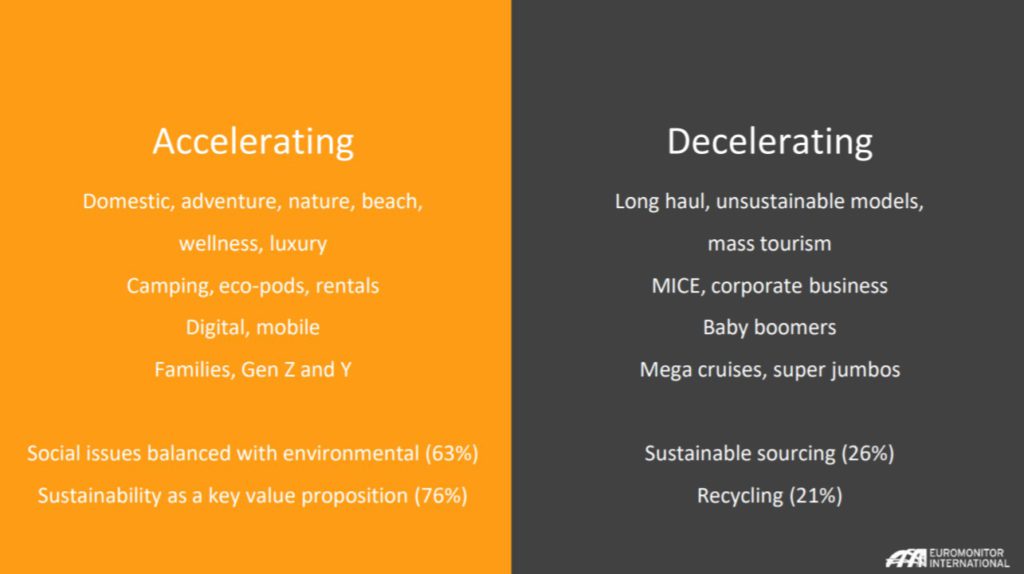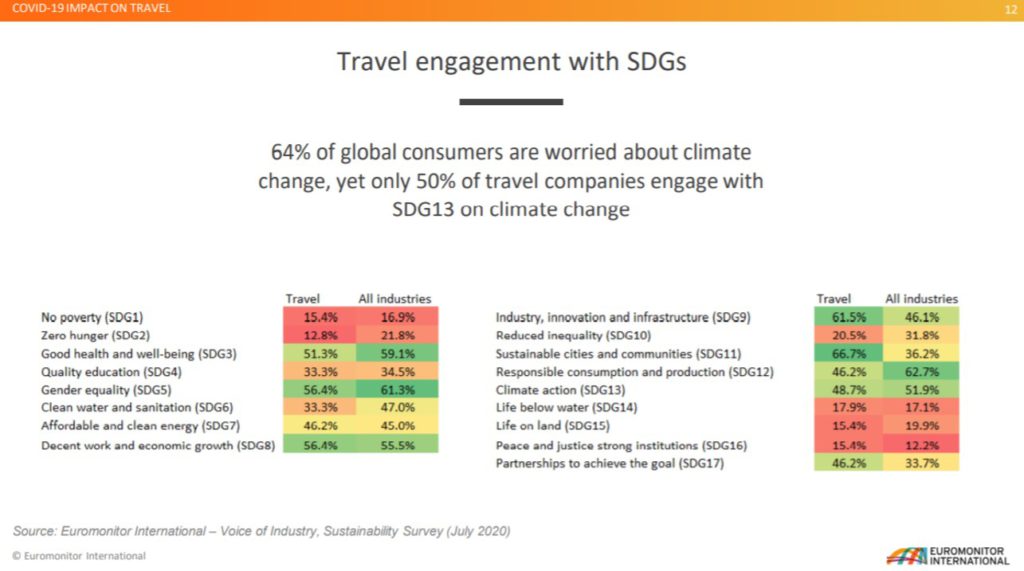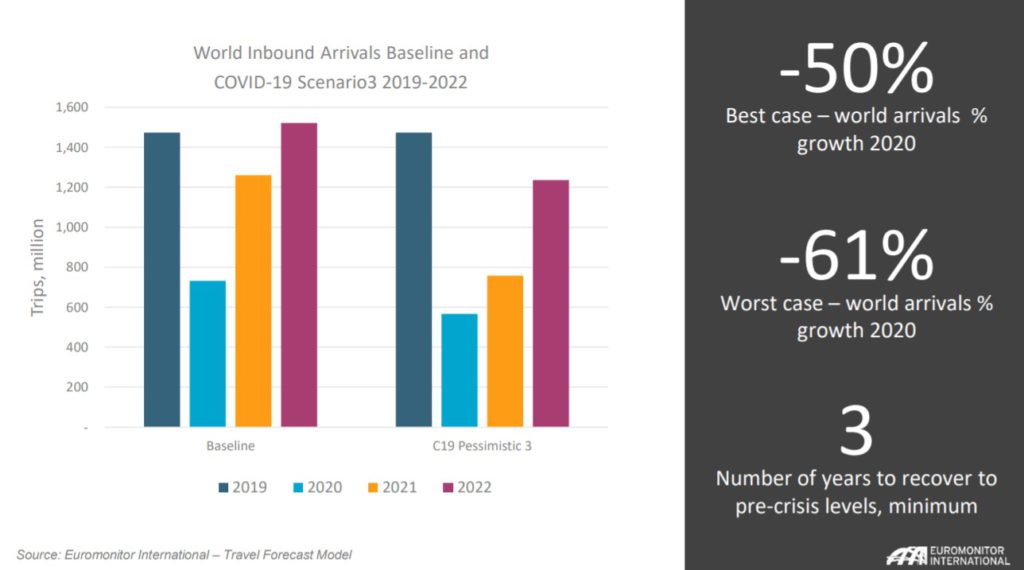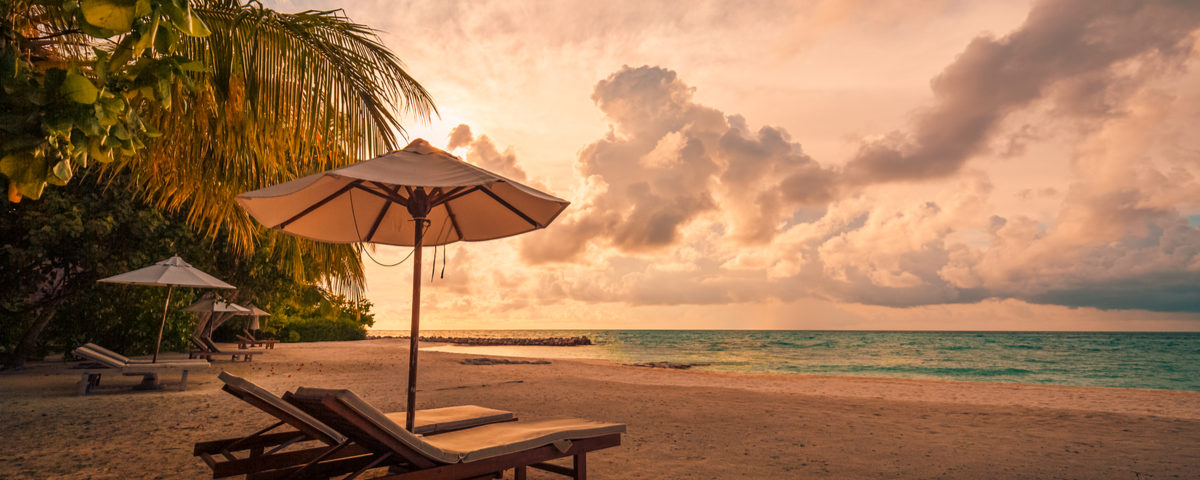
Recently Euromonitor produced a webinar called Travel 2040 – Sustainability and Digital Transformation as Recovery Drivers. (Click the link to access the webinar or download the slides). Slide 11 highlights a series of trends taking place in 2020, either directly in response to COVID, or that have been intensified by the pandemic. Depending upon whether these trends are increasing or diminishing, it refers to them as ‘accelerating’ and ‘decelerating’.
Euromonitor says the following are decelerating: ‘Long haul, unsustainable models, mass tourism, MICE, corporate business, Baby boomers, Mega cruises, super jumbos.’ Leaving aside Baby Boomers (who are not travelling as they are the ones most at risk), the rest – as made clear by the words Mass, Mega, Super Jumbos & Long Haul – are all defined by their scale, and have long been seen as some of the most unsustainable forms of tourism.
More revealing is the observation that in 2020 ‘sustainable sourcing’ and ‘recycling’ are seen as much less important trends than before, although the webinar doesn’t suggest why this might be. I’d like to think it was because people are increasingly aware of the limited impact of recycling, and of the need for far greater engagement with the circular economy. However, the lack of interest in sustainable sourcing suggests otherwise. Considering how much of our industry’s impacts concern our supply chains, a diminishing focus on making them sustainable is not a good sign.
The ‘Accelerating’ column of trends features domestic, adventure, nature, beach, wellness, luxury, camping, eco-pods and rentals. Many of these can be seen as closer to what a sustainable tourism industry might look like, and in the webinar Bremner observes that ‘People want to get off the beaten track, avoid crowds, enjoy nature.’
The worry, again, is scale. How do the world’s places cope if everyone descends on them looking to avoid crowds and enjoy nature at the same time? The experience of the last few months suggests people are seeking these places out not because of their sustainability, but because they offer an escape from being indoors, and for safety. The overcrowded beaches and litter strewn across national parks suggest these trends are not signs of a deepening appreciation of the natural world.
Despite my cynicism, the report observes that ‘sustainability as a key value proposition’ is an important trend for 76% of respondents, which of itself is high. The other growing trend the report highlights is: ‘Social issues balanced with environmental (63%).’ Commenting on this trend in the webinar, Bremner says: “When we looked at travel companies we are seeing greater interest in companies balancing social issues with environmental issues. Because pre-crisis climate change was very much the dominant issue, but that’s now being balanced with social issues.”
As Bremner’s comment makes clear, people continue to see climate change as an environmental issue rather than a social one. Environmental Issues are social issues. As I wrote in my previous blog, issues around race, gender, poverty and environmental degradation are all related. It is the poor and marginalised who suffer most from pollution, can least afford healthy food or clean water, and whose livelihoods are most threatened by the climate emergency.

The next slide (12) only reinforces the travel industry’s disconnect from the climate emergency. According to the slide, while 64% of customers are concerned about climate, only 48% of companies in tourism replied that they were doing anything about it. As Bremner observes during the webinar, this shows: ‘a big disconnect between what travel companies are doing and what consumers are also concerned about.’

This disconnect is further epitomised by the prediction on slide 6 that the industry will take minimum 3 years to recover to pre-crisis levels.
The prediction may or may not come true. The disconnect is that for most of our industry recovery is framed around scale. It is about returning to ‘pre-crisis levels’. Success measured as quantity rather than quality.
Yet the issues that dominated most of 2018 and 2019 were the twin (and related) issues of overtourism and climate change. From resident backlashes to flight shaming, scale was the problem, not the goal.
Recovery cannot be about returning to the old ways. It has to be about learning new, healthier patterns.
If we look carefully, we can see where these patterns are being sketched out, as made clear by a New York Times article last week called: ‘Move over sustainable travel. Regenerative travel has arrived’. The article cites many of the pioneers in this movement, such as founder of Conscious Travel, Anna Pollock. Describing her work with the DMO VisitFlanders (acknowledged by the article as a visionary destination for the way it is rethinking its tourism model), Pollock told the NYT: “We’ve managed to shift the thinking from having their primary objective be about growing the numbers, to creating flourishing destinations, flourishing communities and having them say what kind of tourism they want.”
The time to make this shift is now. Because while our industry looks at its 2019 numbers and wonders how to get back to them, the world outside is preparing for a different future, such as places like Bali, who are using this time without tourists to develop self reliance.
This shift was made clearest to me last week when I stumbled across an innovation challenge called Beyond Tourism In Africa. Launched by the Luc Hoffmann Institute, the African Leadership University’s School of Wildlife Conservation and WWF, the challenge aims ‘to discover and incubate new revenue models that do not depend on tourism, but still enable local communities within African countries to derive income from wildlife, manage their natural resources sustainably, and improve their collective wellbeing’.
How should we respond to a challenge like that? As we imagine our new place in the world, how might such trends change the world? How should they influence our planning? Are we trying to build back to levels the world doesn’t want us to reach?
Rather than trying to return to a world that no longer exists, shouldn’t we be seeing what we can do to help the new one emerge?
You may also be interested in…
- How travel organisations are thinking creatively during the crisis
- Ripping up the travel marketing manual for 2021
- How are biodiversity loss and human disease affecting tourism?


